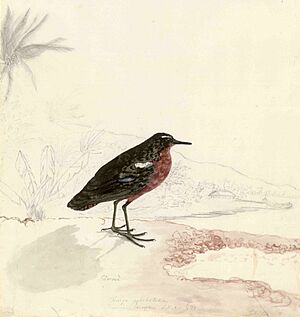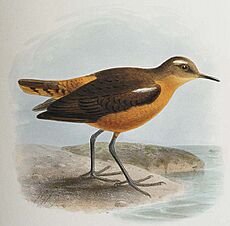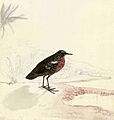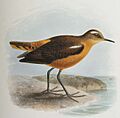Tahiti sandpiper facts for kids
Quick facts for kids Tahiti sandpiper |
|
|---|---|
 |
|
| Forster's drawing | |
| Conservation status | |
| Scientific classification | |
| Synonyms | |
|
Tringa leucoptera Gmelin, 1789 |
The Tahiti Sandpiper (Prosobonia leucoptera) was a small bird that lived only on the island of Tahiti in French Polynesia. It was part of the large wader family, which includes birds like sandpipers and curlews. Sadly, this bird is now extinct, meaning it no longer exists anywhere in the world. It disappeared sometime before the year 1819.
This unique bird was first discovered in 1773 during Captain Cook's second trip around the world. It is believed that only one bird was collected at that time. Today, only one museum specimen of the Tahiti Sandpiper is known to exist. It is kept in the Naturalis Biodiversity Center in the Netherlands. The people of Tahiti called this bird toromē.
How It Got Its Name
The Tahiti Sandpiper was officially described in 1789 by a German scientist named Johann Friedrich Gmelin. He gave it the scientific name Tringa leucoptera. This name came from an earlier description by an English bird expert, John Latham, who had seen a specimen from Tahiti.
Later, in 1850, a French scientist named Charles Lucien Bonaparte placed the bird in a new group, or genus, called Prosobonia. The name leucoptera comes from ancient Greek words meaning "white-winged," which describes a feature of the bird. The meaning of Prosobonia is not fully clear, but it might come from a Greek word meaning "mask" or "face."
What It Looked Like
The Tahiti Sandpiper was a small bird, about 18 centimeters (7 inches) long. It had a plain look, mostly brown in color. Its back and the top and sides of its head and neck were a sooty brown, darker on its wings. It had a small white patch just behind and above its eye. Its chin was a light yellowish-white, and its lower face, rump, and underside were a rusty color.
A special feature was a white patch on its wings, shaped like a crescent moon. Its bill was blackish, thin, and pointed, looking more like a bill for eating insects than for a typical wader. Its legs were a pale straw color with a greenish tint, and its toes were not webbed. It also had a thin, pale rusty ring around its very dark brown eye.
Scientists believe the Tahiti Sandpiper lived near small streams on the island.
The Last Known Bird
The only known specimen of the Tahiti Sandpiper is now in the Naturalis museum. It is thought to have been acquired in 1819 from Georg Forster, who was a naturalist on Captain Cook's second voyage. There is also a painting by Forster that shows this original bird.
There were other similar birds found on the nearby island of Moorea. These were called the Moorea Sandpiper. Scientists are not sure if the Tahiti and Moorea sandpipers were different species, different types of the same species, or just variations due to age or sex. For now, they are usually treated as separate species.
Bones of a related bird have also been found on Mangaia in the Cook Islands. It is difficult for scientists to study these bones and compare them to the Tahiti Sandpiper. They would need to try to get DNA from the bones or from the museum specimen, which could damage the rare specimen.
Images for kids





